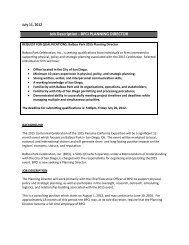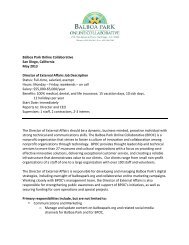Army and Navy Review 1915 Panama-California Edition - Balboa Park
Army and Navy Review 1915 Panama-California Edition - Balboa Park
Army and Navy Review 1915 Panama-California Edition - Balboa Park
You also want an ePaper? Increase the reach of your titles
YUMPU automatically turns print PDFs into web optimized ePapers that Google loves.
Only in recent years have we had company <strong>and</strong> regimental organization<br />
in the Marine Corps, <strong>and</strong> at the present time we have three regularly<br />
organized regiments, two of which are designated as advance base regiments.<br />
An advance base regiment is one which is trained with the idea of<br />
co-operating with the fleet by seizing, fortifying <strong>and</strong> holding some harbor<br />
where the fleet may rendezvous, or where it may seek protection. The<br />
men of an advance base regiment are therefore trained in the l<strong>and</strong>ing <strong>and</strong><br />
placing of heavy guns, up to seven-inch, <strong>and</strong> manning such guns; in placing<br />
<strong>and</strong> h<strong>and</strong>ling of submarine mines; <strong>and</strong> in signal work of all kinds, including<br />
wireless telegraphy.<br />
It is characteristic of the Marine that he must be able to look after<br />
himself, <strong>and</strong> he is, therefore, trained as a signalman, seaman, <strong>and</strong> artillerist,<br />
while primarily he is an infantryman.<br />
A force of Marines ashore in hostile territory is absolutely independent<br />
of other arms of the service, carrying its own artillery, automatic rifles,<br />
engineers, signal corps, etc.<br />
The Marine Corps is an integral branch of the <strong>Navy</strong>, <strong>and</strong> is under the<br />
Secretary of the <strong>Navy</strong>, except when by direction of the President the Corps<br />
or parts thereof may be turned over to the Secretary of War for duty with<br />
the <strong>Army</strong>. One reason why the Marine is not better known to the people<br />
of the United States is, because his deeds have been merged by historians<br />
into chronicles of the <strong>Army</strong> <strong>and</strong> <strong>Navy</strong>. One reads for instance of the naval<br />
battle between the Bon Homme Richard <strong>and</strong> Serapis, without realizing that<br />
in this engagement the Marines of the Bon Homme Richard lost forty-nine<br />
out of a total strength of one hundred <strong>and</strong> thirty-seven; in all the naval<br />
engagements of our country, the Marines have participated, <strong>and</strong> always<br />
with great credit to their Corps <strong>and</strong> to their country.<br />
Not alone have the Marines participated in the naval engagements,<br />
but they have fought shoulder to shoulder with their brothers of the <strong>Army</strong><br />
on many a bloody field. Thus with the army of General Scott during the<br />
Mexican war, a battalion of Marines from the fleet were with the <strong>Army</strong>,<br />
<strong>and</strong> the first regulars who entered the fortress of Chapultepec when Mexico<br />
City was taken, were United States Marines. Major Twiggs, who comm<strong>and</strong>ed<br />
the Marines, was killed in the storming of Chapultepec. After the<br />
occupation of the City of Mexico the battalion of Marines was detailed as a<br />
guard of the Palace.<br />
It was in 1805 that Lieutenant O’Bannon of the Marines, with a small<br />
body of Marines participated in the attack on Derne, Tripoli, after a sevenhundred-mile<br />
march across the desert, <strong>and</strong> first planted the flag of the<br />
United States on foreign soil. There was a battalion of Marines at Bull<br />
Run. In 1812 the Marines fought Malay pirates on the Isl<strong>and</strong> of Sumatra.<br />
In 1836-7 a regiment of Marines co-operated with the <strong>Army</strong> against the<br />
Indians in Georgia, <strong>and</strong> on many occasions in faraway localities, the Marines<br />
have defended the honor of the flag at times that are seldom mentioned<br />
by historians, it being characteristic of the Marine that he be sent ashore<br />
on foreign soil <strong>and</strong> settle various affairs without the historians deeming it<br />
of sufficient importance to note it in history. Thus in 1839 the Marines<br />
participated in minor engagements in the Fiji Isl<strong>and</strong>s, <strong>and</strong> in 1855 took<br />
part in the destruction of a fleet of piratical Chinese junks. They fought<br />
again in the Fiji Isl<strong>and</strong>s in 1858, <strong>and</strong> in the same year Marines were l<strong>and</strong>ed<br />
in Montevideo, Uruguay. It is not generally known that the force under<br />
Colonel Robert E. Lee, that captured John Brown at Harper’s Ferry in<br />
1859, were Marines. In 1859 Marines first l<strong>and</strong>ed in <strong>Panama</strong>. In 1860<br />
Marines were l<strong>and</strong>ed on the west coast of Africa to protect American prop







